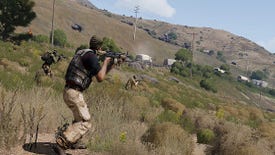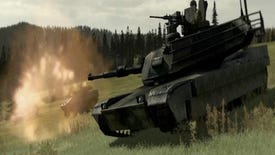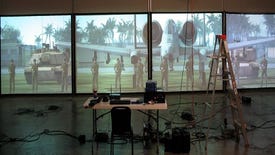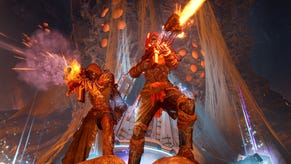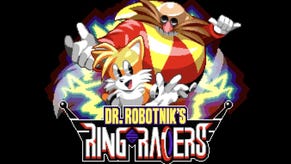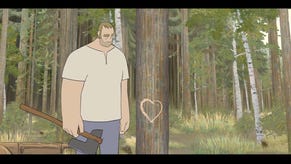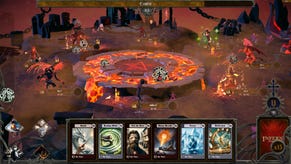Making Of: Operation Flashpoint
[Flashpoint has the dual appeal of being simultaneously one of the most realistic takes on the Soldier game the medium has ever seen and the only one where you can engage in the sport of Tractor hunting in an attack chopper. I've interviewed Marek and his brother a few times over the years, and they're one of the more gloriously eccentric and constantly enthusiastic developers I've met. Last time I was over there, talking about Armed Assault we had a lengthy discussion about how they were programming Butterflies. They develop incredibly militaristic games and they obsess over butterflies. It's hard not to love them.]
Before Bohemia released their classic Soldier-Sim, I had a chance to chat to director Marek Spanel about his life growing up as a games devotee in the Czech Republic. He described sneaking their first computer into the country after a trip to Switzerland. And then, realising there was no way to load or save data, jury-rigging cables to perform the task with their tape recorders. And then learning to program games so, finally, they could achieve their objective of playing a game.
Bohemia are nothing if not shaped by their experiences. And the realistically-tinged eighties-set wargame directly mirrored that. “It was definitely influenced from living behind the Iron Curtain in communism,” Marek explains, “As a kid, listening to the voice of Americans on the radio, and really seeing things from the other side. That was a big influence: a fight against Russians. When you lived in Communism, you felt different about it than when you lived in a Western country and didn’t mind or didn’t understand. We got inspiration to create a kind of anti-communist game.”
However, it was a long and winding route to get there, stretching back before they even were called Bohemia. Not for them the simple design-doc to game in two years of many developers. Its roots goes back years, to the consoles of the early nineties. “We were a long time fan of old computers like the Atari,” recalls Marek, “ In fact, we were working on the Jaguar console in games development. We were working on a 3D game with massive environments of large islands. It was fairly unique, but was never released.” It was eventually put out on the Atari Falcon, the ill-fated sequel to the Atari ST. “The game was fairly good, but it was commercially a disaster for us,” remembers Marek. Entitled Gravon, it sold just over 400 copies.
This left them at an impasse. “We didn’t know what to do,” Marek grins, “What platform to work for?” Perhaps the PC? “We hated the PC!,” Marek growls, “PC? No! Evil Platform!”. Luckily, DirectX was released, along with the first 3D cards. The PC metamorphed from an ugly, awkward duckling to an attractive swan. “We became converts,” Marek states succinctly.
“We decided to develop a simple shooter game called Rio Grande,” explains Marek, “It was a 3D clone of River Raid from the 8-bits. We made a small demo which took us two months to create… but then we saw it and it was so boring. It was nowhere near the game we’d already completed. We didn’t like doing such small scale games. We wanted to do a massive open-world game with no boundaries.”
The route to Flashpoint is becoming clearer, but they weren’t quite there yet. “We started with a concept where you controlled helicopters and APCs, called Poseidon,” says Marek, ”Operation Flashpoint an evolutionary process, where we expanded from that. It took us maybe three years to get more of the gameplay into it”. It was originally quite different. “It was more of a science-fiction/post-nuclear game where you were the last survivors after an apocalypse,” Marek claims, “The last 100 US soldiers and the last 100 soviet soldiers met on an island, and didn’t have any better ideas what to do other than just to fight each other, and they’re the last people on the world.” Worryingly credible.
“We then changed the game into a more real world setting,” Marek continues, “At the same time, we were forced to change the gameplay concept from a fully dynamic campaign to more pre-set objectives.” This was a major alteration, as originally the Flashpoint’s missions were to be generated on the fly by the interactions of the armies on a mass scale. “We didn’t want to but we’d failed to build up an interesting enough dynamic campaign,” Marek laments, “We started by building a non-dynamic training mode, which then developed into the whole game”
Why didn’t it work? “The main problem was that we didn’t really have enough game logic or mechanics working,” Marek ventures, “Units couldn’t find paths, or fight or aim well. Even if we had a proper dynamic campaign objective generation it still didn’t work. You couldn’t even playtest it, as it couldn’t work. The proper thing to do was to build up the physics, AI and other elements together. When everything was working in a linear environment, it’s time to go to a fully dynamic environment. We were trying to do it the other way around.” For fans of ambition, it’s interesting to note that now they hav/ a working game, they’re returning to the Dynamic Campaign idea for their next game…
This incremental approach is very much Bohemia’s philosophy. “We always believed in designing by play,” Marek says, “It’s nice to write a document, but I don’t believe a document can actually describe the game. Especially if the game tries to be innovative. There’s no actual way to judge other than to play. When you design by play, you have to be open to trash your ideas. Some ideas look so nice on the paper… but actually, when in the game, doesn’t work. And when it doesn’t work, you either fix it or just don’t use it. If you keep it there, it’s a disaster.”
“One thing was an on-screen radar,” says Marek, when asking for an example of something which seemed good in theory but in practise proved inadequate, “We had one all the time, even when on foot. In the end the player just looked at the radar instead at the 3D environment. So what was the point in having a world if you never looked at it? We got rid of the radar, and it was such a better game immediately. That was an idea which looked great on paper, as you could see where your troops and waypoints are, but it removed the feeling of being there.”
It had a protracted development to say the least, with the company growing enormously. “It started with just my brother working at home by himself by the game full time," Marek recalls, "Then I joined. Then some artists. We grew up as a company over time. We had a difficult time finding a publisher, who then went bust (Interactive Magic - Ed). Then our new publisher didn’t want the game, so we had to find another publisher. We had one or two years when we had an almost complete product and we just couldn’t find a publisher. That was the most difficult period." Typically, Marek finds the silver lining to this. "It had a good influence on the game," he adds, "We could play more, we could design more…”
That said, when it was released it was, to put it mildly, twitchy. Since then, Bohemia have offered determined post-release support in a mass of patches which fixed problems and generally improved the game. Was this always part of the business plan, or did they have some other motivation? “It was definitely because we were part of the community,” Marek claims, “We felt personally affronted by any shortcomings and bugs. While people did go “You must fix this!”, it’s not obligatory for a developer. However, because we felt responsible, we had to. It wasn’t driven by a business model, in that we didn’t think by releasing the patch we’d get any more money. I have no idea if it helped us, as each patch was an expensive operation for us. The community doesn’t realise that even for a simple thing it needs testing. And if the testing reveals the fix has created another bug, it’s more and more work. It’s possible that it was a commercially smart decision, but there’s no way of telling.”
At the end of this long journey, what wisdom does Marek have to impart? He’s characteristically optimistic. “It’s not true what some people from the industry tell you, that there’s no chance for a new game or no room for innovation, that you should just keep the proven things and do it again,” Marek argues, “Follow your dream or vision, no matter what it is. I’m pretty confident that if you do what you like – what you really like – then even if the idea wasn’t the best idea, that you enjoy it so much makes it a better game. If you work on something you don’t believe, or don’t like, I don’t believe it’s possible to make a great experience. In the end, judge only by yourself, by your friends and people you see playing the game. If you like it… you’re a gamer, after all. If they like it, even better.”






